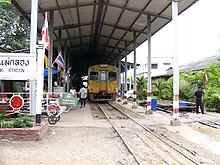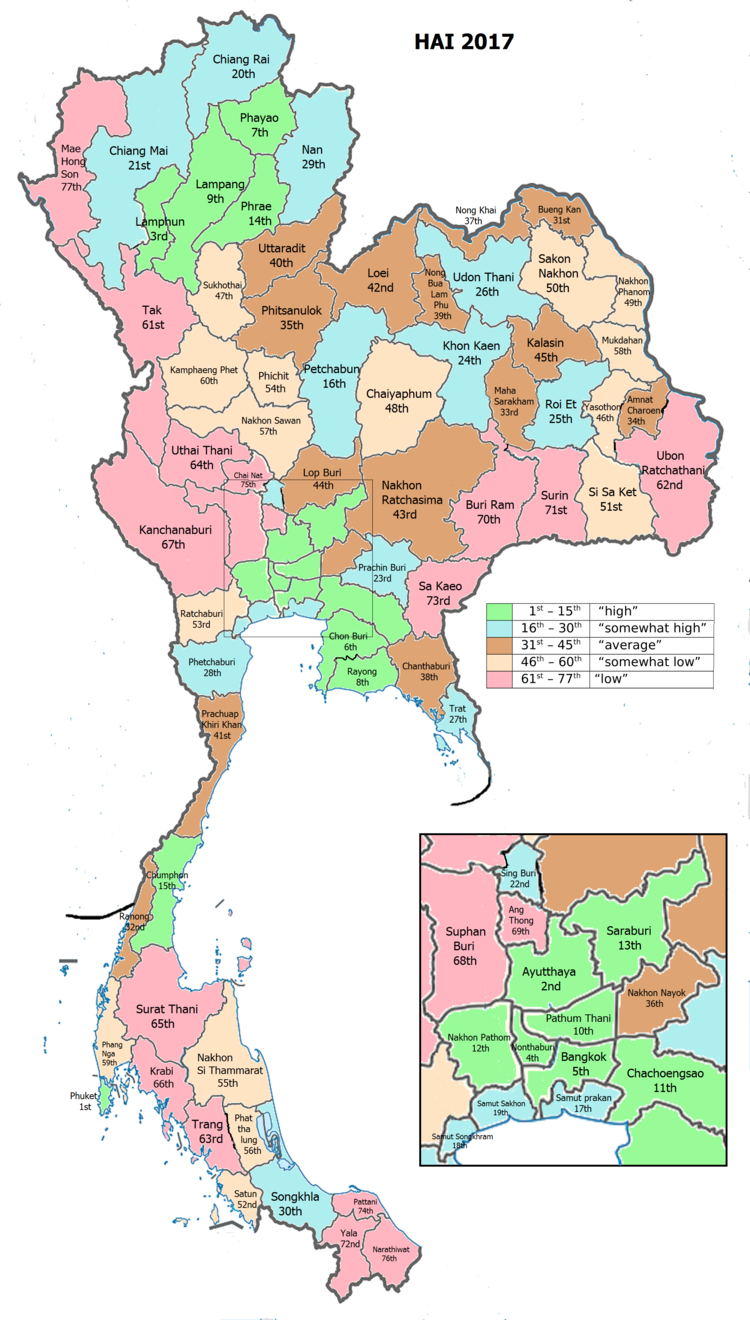Samut Songkhram province
This article is written like a travel guide. (May 2015) |
Samut Songkhram
สมุทรสงคราม | |
|---|---|
 Maeklong Railway Market, also known as Talat Rom Hup when the train arrives | |
| Nickname: Mae Klong | |
 Map of Thailand highlighting Samut Songkhram Province | |
| Country | Thailand |
| Capital | Samut Songkhram |
| Government | |
| • Governor | Charas Bunnasa (since October 2019)[1] |
| Area | |
• Total | 417 km2 (161 sq mi) |
| • Rank | Ranked 77th |
| Population (2018)[3] | |
• Total | 193,791 |
| • Rank | Ranked 76th |
| • Density | 465/km2 (1,200/sq mi) |
| • Rank | Ranked 7th |
| Human Achievement Index | |
| • HAI (2017) | 0.6203 "somewhat high" Ranked 18th |
| Time zone | UTC+7 (ICT) |
| Postal code | 75xxx |
| Calling code | 034 |
| ISO 3166 code | TH-75 |
| Website | www |


Samut Songkhram (Template:Lang-th, pronounced [sā.mùt sǒŋ.kʰrāːm]) is one of the central provinces (changwat) of Thailand.
Neighbouring provinces are (from the south clockwise) Phetchaburi, Ratchaburi and Samut Sakhon. Local people call Samut Songkhram Mae Klong. The province is the smallest in area of all Thai provinces. Chang and Eng Bunker, the famous Siamese twins were born here on 11 May 1811.[5]
Toponymy
The word "samut" originates from the Sanskrit word समुद्र samudra meaning 'ocean', and the word "songkhram" from Sanskrit संग्राम saṃgrāma meaning 'war'.[6]Hence the name of the province literally means 'war ocean'.[7] However, this province is colloquially known as "Mae Klong" after the name of the main river that flows past the area.
Geography
Samut Songkhram is at the mouth of the Mae Klong River to the Bay of Bangkok (upper Gulf of Thailand). With several canals (khlong) the water of the river is spread through the province for irrigation. At the coast are many lakes for producing sea salt. The sandbar Don Hoi Lot at the mouth of the river is famous for its endemic shell population of Solen regularis.
It covers a total area of 416.7 km2 (about 160.9 sq mi). It can be considered the smallest province in Thailand.
This province is home to places of worship of the three major religions. There are 110 Buddhist temples, two Christian churches and one mosque.
History
In the Ayutthaya period the area of Samut Songkhram was known as "suan nok" (Thai สวนนอก, 'outer garden') and was administered by Ratchaburi. During the reign of King Taksin it was made a province. It was the birthplace of Queen Amarindra of King Rama I. The birthplace of King Rama II in Amphawa District is now a memorial park.
Symbols
The provincial seal shows a drum over a river. The Thai word for drum is klong, thus refers to the Mae Klong River, as well as the old name of the province, Mae Klong. On both sides of the river coconut trees are displayed as one of the main products of the province.
The provincial tree is Casuarina equisetifolia. Siamese giant carp (Catlocarpio siamensis) is a provincial fish.[8]
The provincial slogan is "City of Hoi Lot, Top Lychee, King Rama II Memorial Park, the Mae Klong River, and Luangpho Ban Laem".[9]
Administrative divisions
Provincial government
The province is divided into three districts (amphoe). The districts are further divided into 38 subdistricts (tambons) and 284 villages (mubans).
Local government
As of 26 November 2019 there are[10]: one Samut Songkhram Provincial Administration Organisation (ongkan borihan suan changwat) and 9 municipal (thesaban) areas in the province. Samut Songkhram has town (thesaban mueang) status. Further 8 subdistrict municipalities (thesaban tambon). The non-municipal areas are administered by 26 Subdistrict Administrative Organisations - SAO (ongkan borihan suan tambon).[3]
Economy
Samut Songkhram is a leader in Thai salt production, with 4,535 rai worked in 2011 by 111 households to produce salt.[11]
Aside from salt Samut Songkhram is also known for the variety of fruits, especially lychee, pomelo and coconut.
Pla thu (ปลาทู, 'short mackerel') is regarded as an important commercial fish and the most famous product of the province. Mackerel of Samut Songkhram is well known as "Pla thu Mae Klong".[12] Because the area of the province borders the Bay of Bangkok which is rich in plankton, they are regarded as the staple food of this fish species. Therefore, short mackerel of Samut Songkhram has a large body size and the meat is delicious. They can be cooked to a variety of foods such as Pla thu tom madan (ปลาทูต้มมะดัน, 'Pla thu in spicy and sour soup'), Chu chee pla thu (ฉู่ฉี่ปลาทู, 'Pla thu in red curry sauce'), Pla thu sa tia (ปลาทูซาเตี๊ยะ, Pla thu in sweet black soup), burger Pla thu, Pla thu meat, made into a burger filling which can be eaten only in Samut Songkhram.[12] And exclusive Khao tom sam kasat (ข้าวต้มสามกษัตริย์, lit: "three kings porridge"), porridge with the main ingredients, Pla thu, prawn and fresh squid, recount that this menu has its origin from the King Rama V visiting the people at Mae Klong. He has prepared this menu based on his own original ideas until it became a legendary food.[13]
Local traditions
- The Celebrations of King Rama II: organized every early February, which was the birth month of King Rama II at King Rama II Memorial Park.
- Worship and bathing Luangpho Ban Laem ceremony: organized every mid April, which falls on Songkran festival at Wat Ban Laem.[9]
- Mackerel festival: organized regularly at the end of the year (November or December) to promote the consumption of Pla thu at Provincial Hall.[12]


Transport
Rail
Samut Songkhram's main station, Maeklong, is on the Maeklong Railway. The railway is known for its route through the Maeklong Railway Market, nicknamed (Template:Lang-th; RTGS: talat rom hup), meaning the 'umbrella pulldown market'.[14] It is one of the largest seafood markets in Thailand, and is centred on the Maeklong Railway's track.[15] Whenever a train approaches, the awnings and shop fronts are moved back from the rails, to be replaced once the train has passed.[16]
Road
Rama II Road is a main road of Samut Songkhram, it is a road that leads to south as well as Petchkasem Road, starting from Bangkok's Thonburi side. Its named in honour to King Rama II. Samut Songkhram is about 63 km (39 mi) from Bangkok by this road.[9]
The famous floating market, Talat Nam Amphawa can be reached by this road.[9]
Human achievement index 2017
| Health | Education | Employment | Income |
| 45 | 75 | 9 | 74 |
| Housing | Family | Transport | Participation |

|
 |

|
|
| 76 | 69 | 77 | 19 |
| Province Mae Hong Son, with an HAI 2017 value of 0.4637 is "low", occupies place 77 in the ranking. | |||
Since 2003, United Nations Development Programme (UNDP) in Thailand has tracked progress on human development at sub-national level using the Human achievement index (HAI), a composite index covering all the eight key areas of human development. National Economic and Social Development Board (NESDB) has taken over this task since 2017.[4]
| Rank | Classification |
| 1 - 15 | "high" |
| 16 - 30 | "somewhat high" |
| 31 - 45 | "average" |
| 45 - 60 | "somewhat low" |
| 61 - 77 | "low" |
| Map with provinces and HAI 2017 rankings |

|
Notes
Reports (data) from Thai government are "not copyrightable" (Public Domain), Copyright Act 2537 (1994), section 7.
References
- ^ "ประกาศสำนักนายกรัฐมนตรี เรื่อง แต่งตั้งข้าราชการพลเรือนสามัญ" [Announcement of the Prime Minister's Office regarding the appointment of civil servants] (PDF). Royal Thai Government Gazette. 136 (Special 242 Ngor). 26. 28 September 2019. Retrieved 24 November 2019.
- ^ Advancing Human Development through the ASEAN Community, Thailand Human Development Report 2014, table 0:Basic Data (PDF) (Report). United Nations Development Programme (UNDP) Thailand. pp. 134–135. ISBN 978-974-680-368-7. Retrieved 17 January 2016, Data has been supplied by Land Development Department, Ministry of Agriculture and Cooperatives, at Wayback Machine.
{{cite report}}: CS1 maint: postscript (link) - ^ a b "รายงานสถิติจำนวนประชากรและบ้านประจำปี พ.ศ.2561" [Statistics, population and house statistics for the year 2018]. Registration Office Department of the Interior, Ministry of the Interior (in Thai). 31 December 2018. Retrieved 20 June 2019.
{{cite web}}: Cite has empty unknown parameter:|1=(help) - ^ a b Human achievement index 2017 by National Economic and Social Development Board (NESDB), pages 1-40, maps 1-9, retrieved 14 September 2019, ISBN 978-974-9769-33-1
- ^ Phataranawik, Phatarawadee (13 May 2018). "Descendants celebrate Siamese Twins and Thai-US friendship". The Nation. Retrieved 14 May 2018.
- ^ "สงคราม - Wiktionary". Retrieved 2020-03-26.
- ^ "สมุทรสงคราม มาจากไหน? ค้นหลักฐานเมืองจากสมัยสมเด็จพระบรมไตรโลกนาถ" [Where did Samut Songkhram come from? search for the city evidence from the King Borommatrailokkanat's reign]. Silpa Wattanatham (in Thai). 2019-10-15. Retrieved 2020-02-23.
- ^ Suraset Meesin (story) and Editorial Team (photos), ปลาเด็ด 77 จังหวัด #6 (Cool fish in 77 provinces #6), Aquarium Biz, Vol. 4 Issue 44 (February 2014) Template:Lang-th
- ^ a b c d koi_la_zy (22 September 2011). "จังหวัดสมุทรสงคราม" [Samut Songkhram province]. Mthai (in Thai). Retrieved 23 December 2019.
- ^ "Number of local government organizations by province". dla.go.th. Department of Local Administration (DLA). 26 November 2019. Retrieved 10 December 2019.
60 Samut Songkhram: 1 PAO, 1 Town mun., 8 Subdistrict mun., 26SAO.
- ^ Wattanavanitvut, Phongthai (10 September 2016). "Salt industry prepares for a shake-up". Bangkok Post. Retrieved 10 September 2016.
- ^ a b c Srimaneekulroj, Kanin (11 December 2015). "Fish for a compliment". Bangkok Post. Retrieved 22 December 2019.
- ^ Bunnag, Rome (2018-11-16). "ปลาทู อาหารคนจนจริงหรือ? เปิดตำนาน "ข้าวต้มสามกษัตริย์" ตำรับ ร.๕ ทรงประดิษฐ์!!" [Pla thu really poor food? opening the legend of "Khao tom sam kasat", recipe of Rama V the royal invented!!]. ASTV Manager (in Thai). Retrieved 2019-12-31.
- ^ "Maeklong Railway Market: Marketplace With a Railway Track Through it". Amusing Planet. Retrieved 12 Mar 2013.
- ^ "The Mae Khlong Mahachai Railway". Thailand by Train. Retrieved 12 March 2013.
- ^ Cunningham, Susan. "The Market Where a Train Runs Through". Southeast Asia Traveler. Retrieved 12 Mar 2013.
External links
 Samut Songkhram travel guide from Wikivoyage
Samut Songkhram travel guide from Wikivoyage- Province page from the Tourist Authority of Thailand Archived July 16, 2012, at the Wayback Machine
- Provincial website (Thai)
- Samut Songkhram provincial map, coat of arms and postal stamp Archived May 29, 2015, at the Wayback Machine



